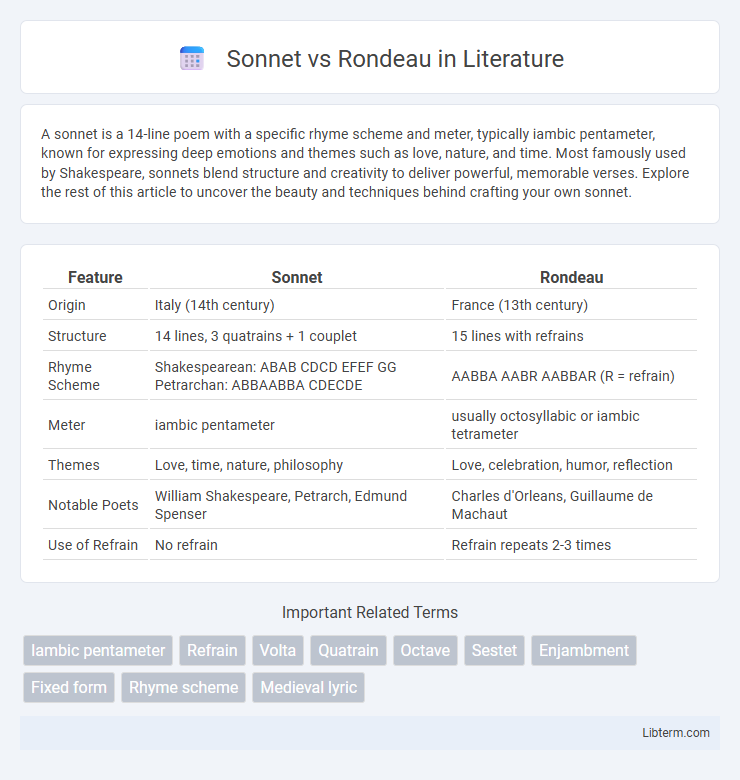A sonnet is a 14-line poem with a specific rhyme scheme and meter, typically iambic pentameter, known for expressing deep emotions and themes such as love, nature, and time. Most famously used by Shakespeare, sonnets blend structure and creativity to deliver powerful, memorable verses. Explore the rest of this article to uncover the beauty and techniques behind crafting your own sonnet.
Table of Comparison
| Feature | Sonnet | Rondeau |
|---|---|---|
| Origin | Italy (14th century) | France (13th century) |
| Structure | 14 lines, 3 quatrains + 1 couplet | 15 lines with refrains |
| Rhyme Scheme | Shakespearean: ABAB CDCD EFEF GG Petrarchan: ABBAABBA CDECDE |
AABBA AABR AABBAR (R = refrain) |
| Meter | iambic pentameter | usually octosyllabic or iambic tetrameter |
| Themes | Love, time, nature, philosophy | Love, celebration, humor, reflection |
| Notable Poets | William Shakespeare, Petrarch, Edmund Spenser | Charles d'Orleans, Guillaume de Machaut |
| Use of Refrain | No refrain | Refrain repeats 2-3 times |
Introduction to Sonnet and Rondeau
The sonnet, a 14-line poetic form with a strict rhyme scheme and meter, originated in Italy and gained prominence through poets like Petrarch and Shakespeare. The rondeau, a lyrical form rooted in French medieval poetry, features 13 or 15 lines with repeating refrains and a distinctive rhyme pattern. Both forms have significantly influenced Western poetry by blending structured rhythm with thematic depth.
Historical Origins of the Sonnet
The sonnet originated in 13th-century Italy, credited primarily to the poet Giacomo da Lentini, and gained prominence through Petrarch's 14th-century works that established its 14-line structure and intricate rhyme schemes. This poetic form influenced Renaissance literature, spreading to England where Shakespeare refined it into the Shakespearean sonnet format. In contrast, the rondeau, with roots in medieval French lyric poetry, typically features a repeating refrain and shorter length, reflecting distinct historical and cultural origins from the sonnet.
Historical Origins of the Rondeau
The rondeau originated in medieval France during the 13th century as a fixed poetic form with roots in French lyrical and musical traditions. It evolved from the concept of refrains used in troubadour and trouvere songs, emphasizing repetition and musicality in both poetry and performance. This form's historical development highlights its role in blending poetry with medieval courtly entertainment and oral culture.
Structural Differences between Sonnet and Rondeau
The sonnet consists of 14 lines with a specific rhyme scheme, typically organized into three quatrains followed by a final couplet in the Shakespearean form or an octave and a sestet in the Petrarchan form. The rondeau features 15 lines divided into three stanzas: a quintet, a quatrain, and a sestet, with only two rhymes and a recurring refrain derived from the poem's opening phrase. Sonnet structure emphasizes thematic development through its volta or turn, while the rondeau relies on repetition and a musical pattern to create cohesion.
Rhyme Schemes: Sonnet vs Rondeau
Sonnet rhyme schemes typically follow patterns such as the Shakespearean ABABCDCDEFEFGG or the Petrarchan ABBAABBACDCDCD, emphasizing structured quatrains and couplets. Rondeau features a repetitive rhyme scheme, commonly AABBA AABR AABBAR, where the refrains create musicality through recurrent rhymes and repeated lines. The sonnet's intricate rhyme sequence contrasts with the rondeau's cyclic, repetitive rhyming, highlighting different poetic traditions and structural functions.
Thematic Focus and Subject Matter
Sonnets frequently explore themes of love, mortality, and beauty through a structured 14-line format that allows for a clear progression of ideas or emotions. Rondeaux often emphasize themes of celebration, nature, or social commentary, using a repetitive refrain that creates a rhythmic and musical quality. While sonnets delve into introspective and philosophical subjects, rondeaux concentrate on lighthearted, lyrical expressions tied to communal or festive contexts.
Meter and Rhythm Comparison
The Sonnet typically follows iambic pentameter, featuring ten syllables per line with a natural da-DUM da-DUM rhythm that creates a steady, flowing cadence. In contrast, the Rondeau employs a more flexible rhythm often in octosyllabic or decasyllabic lines, with repetitive refrains that emphasize rhythmic patterns through recurrence. Meter in the Sonnet is strict and uniform, reinforcing its structured thematic development, while the Rondeau's rhythm relies on repetition for musicality and a cyclical feel.
Notable Examples of Sonnets
Notable examples of sonnets include William Shakespeare's 154 sonnets, which explore themes of love, time, beauty, and mortality with intricate rhyme schemes and iambic pentameter. Petrarch's sonnets, particularly those in the "Canzoniere," set the standard for the Italian sonnet form and influenced Renaissance poetry with their introspective and idealized portrayal of love. John Milton's sonnet "When I Consider How My Light is Spent" exemplifies the form's use for personal reflection and spiritual contemplation.
Famous Rondeau Compositions
Famous rondeau compositions often include Guillaume de Machaut's "Rose, liz, printemps, verdure," a quintessential example from the 14th century showcasing the intricate structure and melodic repetition characteristic of the form. Unlike sonnets, which are primarily poetic and focus on iambic pentameter and rhyme schemes like ABABCDCDEFEFGG, rondeaux emphasize a cyclical refrain that appears at the beginning and end, creating a musical and lyrical harmony. Modern composers like Gabriel Faure and Claude Debussy have also contributed to the rondeau tradition through orchestral and piano works that maintain the form's repetitive, lyrical essence.
Which Form to Choose for Your Poetry?
Choosing between a sonnet and a rondeau depends on your poetic intention and thematic focus. Sonnets, with their 14-line structure and intricate rhyme schemes, excel in exploring complex emotions and philosophical ideas. Rondeaus, shorter and more repetitive with a distinctive refrain and 13 lines, are ideal for musicality and light-hearted or lyrical themes.
Sonnet Infographic

 libterm.com
libterm.com